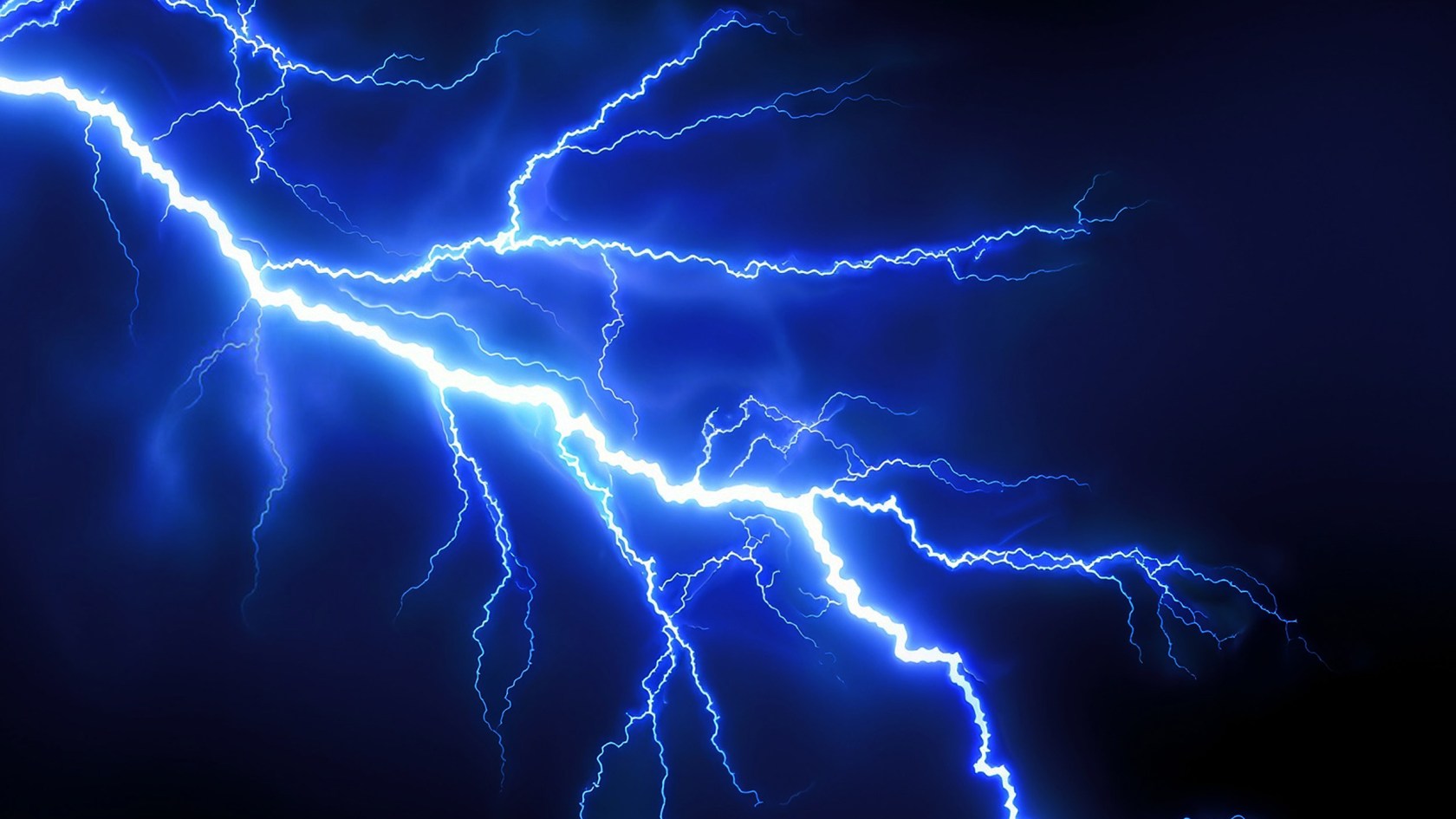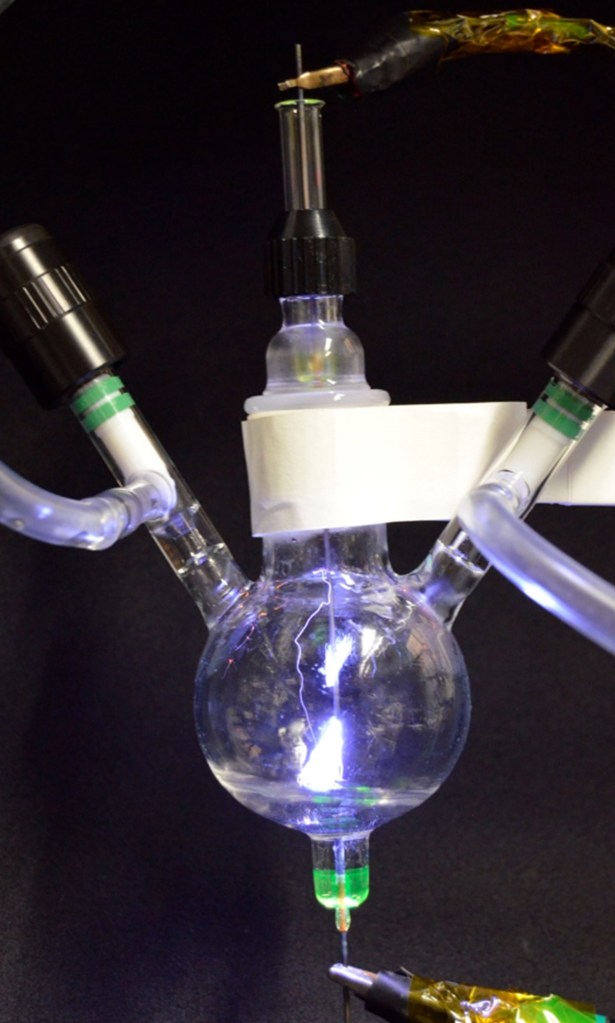How did life begin on Earth? A lightning strike of an idea.

Researchers mimic early conditions on barren planet to test hypothesis of ancient electrochemistry
About four billion years ago, Earth resembled the set of a summer sci-fi blockbuster. The planet’s surface was a harsh and barren landscape, recovering from hellish asteroid strikes, teeming with volcanic eruptions, and lacking enough nutrients to sustain even the simplest forms of life.
The atmosphere was composed predominantly of inert gases like nitrogen and carbon dioxide, meaning they did not easily engage in chemical reactions necessary to form the complex organic molecules that are the building blocks of life. Scientists have long sought to discover the key factors that enabled the planet’s chemistry to change enough to form and sustain life.
Now, new research zeroes in on how lightning strikes may have served as a vital spark, transforming the atmosphere of early Earth into a hotbed of chemical activity. In the study, published in Proceedings of the National Academy of Sciences, a team of Harvard scientists identified lightning-induced plasma electrochemistry as a potential source of reactive carbon and nitrogen compounds necessary for the emergence and survival of early life.
“The origin of life is one of the great unanswered questions facing chemistry,” said George M. Whitesides, senior author and the Woodford L. and Ann A. Flowers University Research Professor in the Department of Chemistry and Chemical Biology. How the fundamental building blocks of “nucleic acids, proteins, and metabolites emerged spontaneously remains unanswered.”
One of the most popular answers to this question is summarized in the so-called RNA World hypothesis, Whitesides said. That is the idea that available forms of the elements, such as water, soluble electrolytes, and common gases, formed the first biomolecules. In their study, the researchers found that lightning could provide accessible forms of nitrogen and carbon that led to the emergence and survival of biomolecules.

A plasma vessel used to mimic cloud-to-ground lightning and its resulting electrochemical reactions. The setup uses two electrodes, with one in the gas phase and the other submerged in water enriched with inorganic salts.
Credit: Haihui Joy Jiang
Researchers designed a plasma electrochemical setup that allowed them to mimic conditions of the early Earth and study the role lightning strikes might have had on its chemistry. They were able to generate high-energy sparks between gas and liquid phases — akin to the cloud-to-ground lightning strikes that would have been common billions of years ago.
The scientists discovered that their simulated lightning strikes could transform stable gases like carbon dioxide and nitrogen into highly reactive compounds. They found that carbon dioxide could be reduced to carbon monoxide and formic acid, while nitrogen could be converted into nitrate, nitrite, and ammonium ions.
These reactions occurred most efficiently at the interfaces between gas, liquid, and solid phases — regions where lightning strikes would naturally concentrate these products. This suggests that lightning strikes could have locally generated high concentrations of these vital molecules, providing diverse raw materials for the earliest forms of life to develop and thrive.
“Given what we’ve shown about interfacial lightning strikes, we are introducing different subsets of molecules, different concentrations, and different plausible pathways to life in the origin of life community,” said Thomas C. Underwood, co-lead author and Whitesides Lab postdoctoral fellow. “As opposed to saying that there’s one mechanism to create chemically reactive molecules and one key intermediate, we suggest that there is likely more than one reactive molecule that might have contributed to the pathway to life.”
The findings align with previous research suggesting that other energy sources, such as ultraviolet radiation, deep-sea vents, volcanoes, and asteroid impacts, could have also contributed to the formation of biologically relevant molecules. However, the unique advantage of cloud-to-ground lightning is its ability to drive high-voltage electrochemistry across different interfaces, connecting the atmosphere, oceans, and land.
The research adds a significant piece to the puzzle of life’s origins. By demonstrating how lightning could have contributed to the availability of essential nutrients, the study opens new avenues for understanding the chemical pathways that led to the emergence of life on Earth. As the research team continues to explore these reactions, they hope to uncover more about the early conditions that made life possible and to improve modern applications.
“Building on our work, we are now experimentally looking at how plasma electrochemical reactions may influence nitrogen isotopes in products, which has a potential geological relevance,” said co-lead author Haihui Joy Jiang, a former Whitesides lab postdoctoral fellow. “We are also interested in this research from an energy-efficiency and environmentally friendly perspective on chemical production. We are studying plasma as a tool to develop new methods of making chemicals and to drive green chemical processes, such as producing fertilizer used today.”
Harvard co-authors included Professor Dimitar D. Sasselov in the Department of Astronomy and Professor James G. Anderson in the Department of Chemistry and Chemical Biology, Department of Earth and Planetary Sciences, and the Harvard John A. Paulson School of Engineering and Applied Sciences.
The study not only sheds light on the past but also has implications for the search for life on other planets. Processes the researchers described could potentially contribute to the emergence of life beyond Earth.
“Lightning has been observed on Jupiter and Saturn; plasmas and plasma-induced chemistry can exist beyond our solar system,” Jiang said. “Moving forward, our setup is useful for mimicking environmental conditions of different planets, as well as exploring reaction pathways triggered by lightning and its analogs.”





